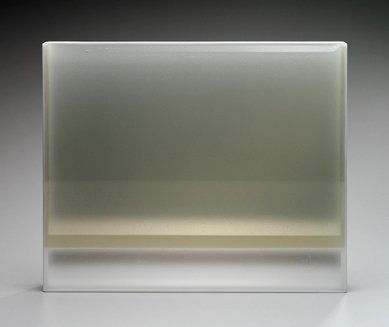

Jessica Loughlin:
Seeing Farther
SOFA West 2009,
Santa Fe, NM
by Richard Speer
As biographer Laurie Lisle has noted, painter Georgia O’Keeffe found deep resonance in the wilds of northern New Mexico because there, in the dry, sage-scented air, she could “see farther.” Lisle’s observation pertains both literally—to the crystalline visibility extending to distant mesas and mountains—and symbolically—to the region’s near-mystical atmospherics and topography, which helped O’Keeffe tap into the farthest reaches of her creative psyche. On the surface, the connection between the late American painter and the contemporary Australian glass artist Jessica Loughlin may not be apparent, yet both women share a preoccupation with landscape as a vehicle to conjure mindscape. In Loughlin’s elegant works—which arts writers most often contextualize in the lineage of minimalism—the artist explores the misty, tremulous lines between earthiness and conceptualism, direct perception and inference. In certain respects, Loughlin is a sensualist who wants to be an ascetic. Perhaps it is the other way around. In either permutation, it is the tensions between those polarities that have come to define and distinguish her work.
Born in Melbourne in 1975, Loughlin has always been intensely focused and ambitious. Beginning at the rosy age of six, she studied Sumi-e and suibokuga painting under Richard Liddicut, and gleaned from those process-intensive disciplines an appreciation for the infinitudes of gray that follow from the mixings of inks with water. “I believe that my palette,” she says today, “came directly from that early formal training.”
The rigor imparted by that exposure to Chinese and Japanese painting stayed with her through her young womanhood, through her studies at the prestigious Glass Workshop at Australian National University, and into her many series in the decade-plus since her graduation. The gradations between states of being—white to black, liquid to gas, recumbent to upright—combine with a longstanding fascination with landscape to form the core of the artist’s approach. Traveling through and flying over the deserts and sprawling plains of Australia has heightened her awareness of the natural world and the structures humankind imposes upon it. Make no mistake, though: By temperament and orientation, she is no hippie-dippy Earth Mother intent on becoming “one with the land.” Rather, is keenly focused on her—and out—separation from the land. Indeed, separation and distance from primary experience are intrinsic to her viewpoint.
So are the properties of the glorious Australian continent itself: not only “its vast space and sense of distance,” she clarifies, “but also by the inherent sense of quiet and stillness, unlike any other country.” Loughlin communicates this stillness through timeless forms, most consistently the rectangle and the horizon line, “which is the farthest distance we see on earth.” While she has worked in many formats, including vertical, square, and round, her études on horizontality and symmetry are the pieces for which she is perhaps best known. She makes a point to stress that the forms she uses to portray quietude and serenity “are not dynamic shapes that have energy to them; rather, they are as unassuming as possible.” This reductivism, which attains near-hermetic austerity, is evident in the luminous sculpture, Through Distance #1 (2006), which is part of the collection of the New Mexico Museum of Art. The piece reminds the viewer of vistas beheld and emotions experienced that can be recalled but never fully reconstituted.
Today, living in Adelaide, South Australia, an arid region adjacent to salt lakes and desert, Loughlin is enveloped within a landscape that is eerily worn down by primeval torrents and currents that have long since ceased to flow. It is, as Loughlin puts it, a land “shaped by the memory of water.” In the absence of surging tides and downpours, then, in the absence, too, of volcanic and tectonic activity, there is a kind of ancient deadness here, which speaks of stasis, inertia, and the wisdom of things that do not move.
As profoundly as this artist responds to the immensity and isolation surrounding Adelaide, she gravitated to the city because of the vitality of its local culture: wine-makers, filmmakers, music-makers, university students—not to mention the bustling glass studio known as the Jam Factory. Loughlin herself founded a communal studio, Gate 8, where she thrives on dialogue with fellow artists—surprising, perhaps, for a person so dedicated to the portrayal of stillness. In her studio she incorporates a sense of play into her practice: building models, mixing incongruous materials, conducting myriad tests and experiments with materials, some of which yield exquisite results and others which, she allows, “are pretty ugly!” These experiments allow her to build up a library of techniques and ideas to mine in the future.
In the time- and labor-intensive works she creates at Gate 8, there is a Zen quality aimed at evoking a sense of psychic space, calm, and contemplation in the viewer. She draws inspiration from the constructs of minimalism, most notably the late Agnes Martin, but also from artists, photographers, and architects as disparate as Roni Horne, Andreas Gursky, Howard Taylor, Rover Thomas, Tadao Ando, and Peter Zumthor. Despite their rich interior bubblescapes and immaculate surfaces, Loughlin’s kilncast, fused, coldworked, and cut planes exude an overarching sense of emanation, recalling Mark Rothko both in fuzzy rectilinearity and the suggestion of vaporous, expansive, everlasting space. The ideations Jessica Loughlin so fluently coaxes, grinds, polishes, and sheerly wills out of her chosen material are testaments to its malleability and her vision. “Focus is important to my practice,” she says, “to achieve a deep understanding of the subtleties that I’m looking to exploit. I get quite excited about pushing the material of glass, and yet always being mindful to balance that control with letting the material have its own life.”
BACK TO CATALOGUE ESSAY MENU
BACK TO RICHARD'S WELCOME PAGE
BACK TO RICHARD'S RESUME